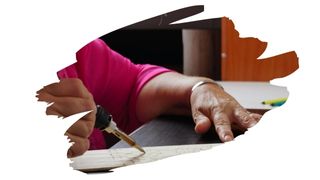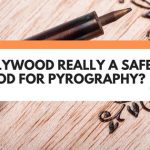Whether you’re a dab hand at pyrography — or new to the art form — either way, you need the right type of wood for your canvas. Especially when everything from grain texture to sap content, can all impact the clarity of your designs.
But what does this all mean when it comes down to wood burning with a timber such as Basswood?
Well, in this post, we dive into the four main criteria that you need to check for when it comes to selecting a pyrography wood. You will also learn which popular North American hardwood is ideal for wood burning artwork.
And keep reading to find out the best smoke-filtering face mask you can buy.

This post may contain affiliate links to products that we receive a commission for (at no additional cost to you). Learn more here.
What Is The Best Type Of Wood For Pyrography?
The best types of wood for pyrography tend to meet the following four criteria:
1). Light Color Grain
Wood types with light grain provide the perfect backdrop for dark burn lines. This contrast means that your images come out clear, and your shading doesn’t become obscured by the background.
2). Fairly Uniform Grain
Any lumber with a very distinct contrasting grain texture, (such as Red Oak), can impact the clarity of your images.
Related Post: Beginners Guide To Reducing Oak Grain Contrast (Explained)
So, burning designs onto these types of wood can make your art look more like a faded photocopy.
3). Very Little Tree Sap/Pitch
Wood types that have a lot of tree resins saturating their grain can be a problem when it comes to drawing on them.
As you burn into the wood, the resins inside their grain can heat up and bubble over. And this, in turn, will interfere with the clarity of your artwork — especially when it comes to shading.
That’s why sap-rich wood types, (such as Pine and Cedar), are so difficult to work with when it comes to pyrography.
Side Note: If that sap-saturated timber has been kiln-dried, it should have very little sap in it for you to worry about.
Related Post: Is Kiln Dried Wood Safe Enough To Use For Gardens And Landscaping?
4). The Wood Should Be Non-Toxic
There are some types of timber that should never be burned in any way shape or form.
Poisonous trees, (such as the Yew tree), contain toxic compounds. And many manufactured wood types have been chemically treated, such as Plywood or MDF. So, burning these particular woods also carries increased health risks too.
Related Post: Is Plywood Really A Safe Wood For Pyrography?
Basically, burning these wood types risks releasing those compounds in the smoke as you burn them. And those smoky fumes are too dangerous to have wafting around in the air of your workshop.
So What About Basswood? Is Basswood Good For Pyrography?
Absolutely it is. In fact Basswood, (sometimes referred to as Linden wood), is probably your single best choice for wood burning.
This lumbers fine uniform grain is light enough that the lines of your drawings will show up clearly. It doesn’t contain much in the way of tree resins, so you needn’t worry about bubbling sap.
And, best of all, it is both affordable and easily accessible, as this hardwood grows abundantly across North America.
Is Linden Wood Good For Pyrography? Basswood and Linden wood are basically the same wood species. They both belong to the Tilia tree genus. However, Linden wood is the European sub-species version of Basswood. While Basswood grows natively around the most northern parts of North America.
But Isn’t Basswood Toxic When Burned?
Smoke, in and of itself, is bad for our health. So, you should not inhale big lungful’s of it, no matter which wood happens to be burning.
However, natural Basswood does not contain any additional toxic or poisonous compounds. And this simple fact makes it a clean burning wood.
Nevertheless, even though it is a clean burning timber, you should still take the proper precautions. Which means you should always wear a face mask whenever you burn this wood.
And What Type Of Mask Do You Recommend?
Whatever face mask you get needs to be able to filter out smoke particulates. So, wrapping a cloth bandanna around your mouth simply isn’t going to cut it!
Now, air polluting particles are measured in microns. And, when it comes to smoke, the average smoke particle is around 2.5 microns small.
But, wildfire smoke particles, (which tend to be even smaller than the average smoke particle), can be as tiny as 0.4 microns. So, you’ll need a mask that can filter out particles that small (just to be on the safe side).
Which is why you should purchase RZMask’s M2 face mask.
The RZMask’s M2 mask has a breathable mesh that can filter particles as small as 0.1 microns. And, thanks to its adjustable nose clip, you can easily get this face mask to fit comfortably and securely.
You can learn more about this reusable smoke filtering face mask over on Amazon.
Should You Stain Basswood Before Wood Burning? Only apply wood stain AFTER you’ve finished wood burning your designs. Wood stains are oily resins with a consistency similar to tree resins. So, burning wood-stained surfaces can also mess with the clarity of your designs. What’s more, those oily stains will also create an excessive amount of smoke.
And Where Can You Go To Buy Wood For Pyrography?
The best place to buy Basswood is to simply go online and order them in bulk. There are plenty of suppliers selling stacks of this hardwood, readily prepared for drawing onto.
So, if you want to get some ready-to-use Basswood rounds in bulk, then check out Wilson Enterprises Store. They provide natural kiln-dried Basswood rounds at very affordable prices.
To Wrap Up, Here Are The 3 Key Takeaways From This Post…
1). The best type of wood for pyrography will have a lightly colored, (and fairly uniform), grain texture.
2). Try and avoid burning any wood that has a lot of tree sap in it. And always avoid burning any wood that may contain toxic compounds and/or chemicals.
3). The best type of pyrography wood is Basswood. Its pale fine grain provides the perfect canvas for your artwork.
References:
Particulate Matter (PM) Basics | EPA.gov



